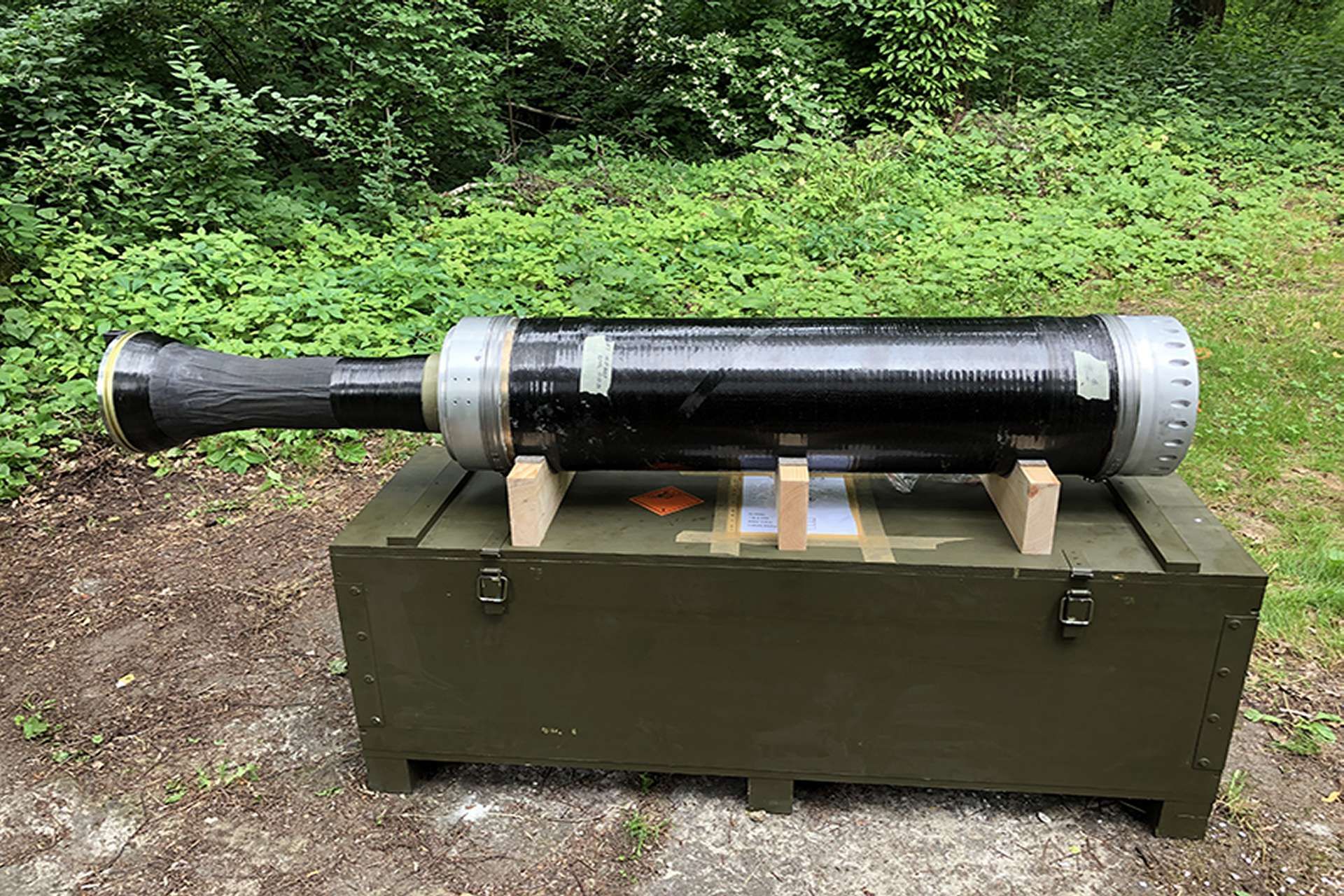Breaking News
Poland Uses Three-Stage 300 mm Suborbital Rocket Engine Program to Develop Ballistic Missile Technology.
At the International Defence Industry Exhibition (MSPO) 2024, the Military Institute of Armament Technology (WITU) is presenting an ambitious project to develop a three-stage suborbital rocket system equipped with a 300 mm diameter rocket engine. This project, titled "Development of a Three-Stage Suborbital Rocket System for Research Payload Launches," aims to create a reusable suborbital launch system capable of carrying a 40 kg payload beyond the Karman Line, to an altitude of 100 km. The development seeks not only to reduce launch costs for space missions but also to provide new opportunities for microgravity research and exploration of the upper atmosphere.
Follow Army Recognition on Google News at this link

Three-Stage Suborbital Rocket System equipped with a 300 mm diameter rocket engine(Picture source: Army Recognition)
At the exhibition, the Institute showcased a 300 mm diameter rocket engine that has already been tested on a test stand. During the tests, the rocket's guidance system was also verified. The three-stage suborbital rocket is a noteworthy proposal that could also have potential as an air defense weapon. With its dimensional characteristics, it is particularly suited for medium-range air defense. Utilizing its three stages, this rocket could reach a range of up to 150 km.
This same three-stage propulsion system is also employed in the development of a 105 mm missile, integrated into the Sona program for short-range air defense. Designed to protect troops against various aerial threats such as drones and missiles, this system can carry up to 30 thermally guided munitions with an estimated range of 20 km. Its capability to provide effective coverage for ground forces enhances short-range air defense and ensures increased protection in conflict situations.
The suborbital rocket under development consists of three stages: a main stage with a two-segment engine and two additional stages, each with a single-segment engine. The solid rocket motor 300 mm, a key component of the project, uses advanced materials such as composite fibers and lightweight alloy connectors. Its characteristics include a length of 1.79 m for the single segment with nozzle, a total impulse of 251,000 Ns, a total mass of 148 kg with nozzle, a maximum thrust of 39,500 N, a propellant-to-motor weight ratio of 0.7, and a diameter of Ø308 mm. The motor is designed to be modular, allowing adjustments to its length and power based on mission requirements. The propellant used is a molded ammonium perchlorate star mix, ensuring high performance. Preliminary tests, including hydrostatic pressure tests and static nozzle tests, have validated the motor's robustness and effectiveness.
The development of this suborbital rocket system represents a significant advancement for the Polish and European space sectors. It opens new avenues for scientific research and military applications, with expected benefits in terms of reduced launch costs and expanded possibilities for space exploration. This project promises to enhance Poland's position in the space domain while contributing to the advancement of space technologies.
The development of advanced space propulsion technologies has several significant military implications. First, progress in space propulsion can be adapted for more sophisticated missile systems. Technologies developed for suborbital rockets can improve the accuracy, range, and effectiveness of ballistic or cruise missiles, offering substantial benefits for weapon systems.
In terms of testing and validation capabilities, the ability to conduct tests in microgravity and at high altitudes is crucial. These tests allow for the validation of propulsion and guidance technologies, which is essential for assessing and optimizing critical components of missile systems. The results of these tests can be applied to military projects to improve missile performance and reliability.
Regarding deterrence and security, although the projects are primarily focused on scientific research, the developed skills and infrastructure can enhance a country's defense capabilities. Improved understanding of space and launch technologies can bolster deterrence by providing increased capabilities for military applications, contributing to a stronger security environment.
To illustrate Poland's efforts in this field, we can mention the upcoming launch of the ILR-33 Amber 2K rocket from Norway for a space mission. This 4.6-meter rocket, equipped with a hybrid engine and two solid-fuel boosters, is designed to carry a ten-kilogram payload to an altitude of 100 kilometers. It is an upgraded version of the ILR-33 Amber model. The space flight will follow an initial low-altitude test conducted in Poland. Tests are carried out abroad due to the large impact zone of the rocket stages. The launch of the ILR-33 Amber 2K by the Łukasiewicz Institute of Aviation is scheduled for September 7, 2024.
Following this mission, the ILR-33 Amber 2K will be used for suborbital research by the Polish company Thorium Space. This project aims to strengthen Polish capabilities in space rocket technologies and to pave the way for future developments in this field

Military Institute of Armament Technology 300 mm diameter rocket engine (Picture source : Poland MoD)


























